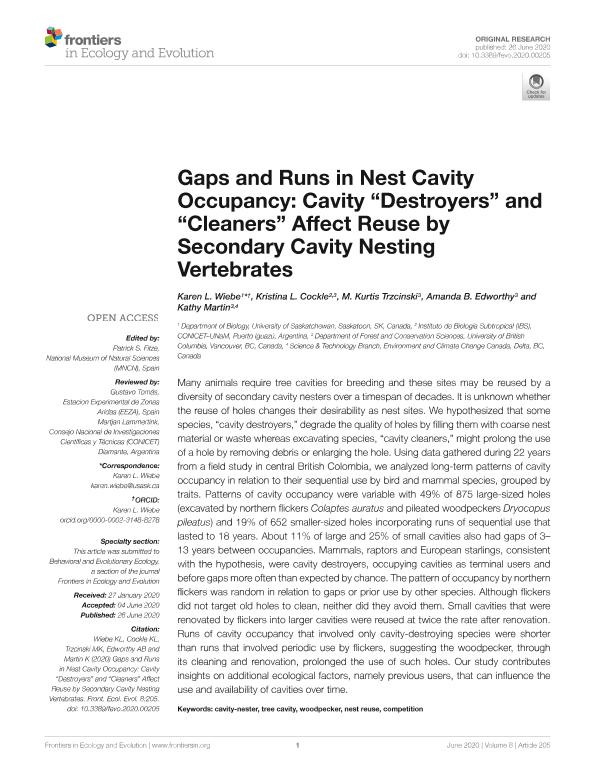Artículo
Gaps and Runs in Nest Cavity Occupancy: Cavity “Destroyers” and “Cleaners” Affect Reuse by Secondary Cavity Nesting Vertebrates
Fecha de publicación:
06/2020
Editorial:
Frontiers Media S.A.
Revista:
Frontiers in Ecology and Evolution
ISSN:
2296-701X
Idioma:
Inglés
Tipo de recurso:
Artículo publicado
Clasificación temática:
Resumen
Many animals require tree cavities for breeding and these sites may be reused by a diversity of secondary cavity nesters over a timespan of decades. It is unknown whether the reuse of holes changes their desirability as nest sites. We hypothesized that some species, “cavity destroyers,” degrade the quality of holes by filling them with coarse nest material or waste whereas excavating species, “cavity cleaners,” might prolong the use of a hole by removing debris or enlarging the hole. Using data gathered during 22 years from a field study in central British Colombia, we analyzed long-term patterns of cavity occupancy in relation to their sequential use by bird and mammal species, grouped by traits. Patterns of cavity occupancy were variable with 49% of 875 large-sized holes (excavated by northern flickers Colaptes auratus and pileated woodpeckers Dryocopus pileatus) and 19% of 652 smaller-sized holes incorporating runs of sequential use that lasted to 18 years. About 11% of large and 25% of small cavities also had gaps of 3–13 years between occupancies. Mammals, raptors and European starlings, consistent with the hypothesis, were cavity destroyers, occupying cavities as terminal users and before gaps more often than expected by chance. The pattern of occupancy by northern flickers was random in relation to gaps or prior use by other species. Although flickers did not target old holes to clean, neither did they avoid them. Small cavities that were renovated by flickers into larger cavities were reused at twice the rate after renovation. Runs of cavity occupancy that involved only cavity-destroying species were shorter than runs that involved periodic use by flickers, suggesting the woodpecker, through its cleaning and renovation, prolonged the use of such holes. Our study contributes insights on additional ecological factors, namely previous users, that can influence the use and availability of cavities over time.
Palabras clave:
CAVITY-NESTER
,
COMPETITION
,
NEST REUSE
,
TREE CAVITY
,
WOODPECKER
Archivos asociados
Licencia
Identificadores
Colecciones
Articulos(IBS)
Articulos de INSTITUTO DE BIOLOGIA SUBTROPICAL
Articulos de INSTITUTO DE BIOLOGIA SUBTROPICAL
Citación
Wiebe, Karen L.; Cockle, Kristina Louise; Trzcinski, M. Kurtis; Edworthy, Amanda B.; Martin, Kathy; Gaps and Runs in Nest Cavity Occupancy: Cavity “Destroyers” and “Cleaners” Affect Reuse by Secondary Cavity Nesting Vertebrates; Frontiers Media S.A.; Frontiers in Ecology and Evolution; 8; 6-2020; 1-11
Compartir
Altmétricas
Items relacionados
Mostrando titulos relacionados por título, autor y tema.
-
Cockle, Kristina Louise ; Trzcinski, Mark Kurtis; Wiebe, Karen L.; Edworthy, Amanda B.; Martin, Kathy (Ecological Society of America, 2019-05)
-
Bonaparte, Eugenia Bianca ; Ibarra Eliessetch, José Tomás; Cockle, Kristina Louise (Elsevier Science, 2020-11)
-
Schaaf, Alejandro Alberto ; Gomez, Maria Daniela ; Ruggera, Román Alberto ; Tallei, Ever Denis ; Vivanco, Constanza Guadalupe ; Politi, Natalia ; Rivera, Luis Osvaldo (Elsevier Science, 2020-05-15)




